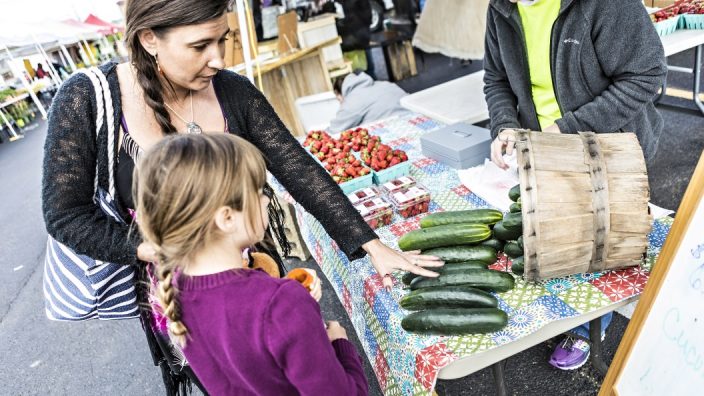Applications for Ohio Farm Bureau Health Plans now available
Members have three ways to apply: contacting a certified agent, calling 833-468-4280 or visiting ohiofarmbureauhealthplans.org.
Read MoreEight-year-old Kaity Grimm darts in and out of the stalls at the Athens Farmers Market, munching on a blueberry muffin and checking out the fresh fruits and vegetables. After careful consideration, she hands the vendor a green token and in return receives a bunch of chard. Racing back to her mother, she thrusts the large leafy greens into her hands and scampers off to another stall.
“Good choice,” said her mother, Jennifer Grimm, as she puts the chard into one of the bags filled with whole wheat bread, strawberries, sunflower sprouts and jam. “Kaity loves coming here and having the freedom to pick out what she wants. She loves fruit and will eat a whole cucumber herself. I’m so glad Heather brought me here.”

While Grimm grew up in the nearby village of Gloucester, she’d never really checked out the market until her friend Heather DeLaPena brought her recently. Grimm, a waitress at Union Street Diner in Athens, discovered most vendors would accept her Electronic Benefits Transfer card – an electronic, debit version of the old food stamp program. She receives financial help for food purchases through the Supplemental Nutrition Assistance Program (SNAP) funded in the 2014 Farm Bill.
Grimm was thrilled to learn she could receive up to $10 worth of fruits and vegetables at the farmers market as part of a program called Produce Perks.
Similar programs under the names Veggie SNAPS, Carrot Cash and Double Up Food Bucks are offered throughout the state and are part of a national effort to give low-income people more access to fresh produce. Some of the funding comes from the five-year, $100 million Food Insecurity Nutrition Incentives program authorized by the federal farm bill, with the rest from local programs or organizations.
Here’s how it works: At the Athens Farmers Market, SNAP recipients swipe their EBT card in a machine run by a market volunteer. For every dollar deducted from their account, they get a gold token. Produce Perks matches the amount deducted – up to $10 per market day visit – to be used for purchasing fruits and vegetables only, and those tokens are green. Farmers who accept Produce Perks tokens are reimbursed at the end of the month. Last year the market took in 4,132 Produce Perks tokens and 22,290 SNAP tokens, said Kip Parker, the market’s manager.
“We’ve gotten a lot of new customers through the Produce Perks program,” said Parker, noting that the area has a lot of individuals and families who are on some type of public assistance. The market also participates in other programs such as the U.S. Department of Agriculture’s Food Assistance Program, Farmers’ Market Nutrition Program and Senior Farmers’ Market Nutrition Program.
At one of the market stalls set up outside a strip mall in Athens, Ed Perkins of Sassafras Farm said he’s noticed an uptick in his produce business since the market purchased an EBT-accessible machine.
“The paper food stamps never really caught on. This program seems to have vastly increased the amount being purchased. I get mostly green tokens now and every day see a dozen or more (SNAP) recipients,” said Perkins, who has been a vendor for more than 30 years.

In Columbus, the program is called Veggie SNAPS and has participation from 14 farmers markets in three counties, up from six in 2014 when the program started. Last year local farmers sold $15,000 worth of fruits and vegetables through the program, helping increase their overall sales, said Amy Baskes, Veggie SNAPS program manager. The program receives financial support from the city of Columbus and Franklin County commissioners who approved $15,000 in support for this year. The program also received funding through Wholesome Wave’s USDA-FINI grant and has had other funders over the last three years.
Baskes, who has worked on local food initiatives for 20 years, is part of an effort to combine all of Ohio’s produce incentive programs into one statewide program called Produce Perks. The initiative received a grant from the Ohio Department of Health to support the statewide rollout this year. Right now just over 100 farmers markets accept SNAP with 76 participating in the produce incentive program, Baskes said.
“For us to grow, we really need more markets to accept EBT. The farm bill has funding available for free or reduced cost EBT equipment,” Baskes said. “The ultimate goal is to increase consumption of fruits and vegetables, keep food dollars local and increase those sales. This is a great healthy food access and economic development effort.”
Feature image: Jennifer Grimm helps Kaity select a cucumber at the Athens Farmers Market.
Photos by James DeCamp


Members have three ways to apply: contacting a certified agent, calling 833-468-4280 or visiting ohiofarmbureauhealthplans.org.
Read More

One of the best decisions Shannon and Heather Utter made a few years ago was looking into a Farm Bureau member benefit that has ended up saving them thousands of dollars on their energy bills.
Read More

Ryan Hiser has experienced first-hand the importance of having the opportunity to vote on issues that will affect his family operation and other farmers.
Read More

Bill Patterson, Cy Prettyman and Adele Flynn will continue to serve as officers for Ohio Farm Bureau Federation.
Read More

Delegates discussed many topics impacting agriculture including farmland preservation, local foods, and succession planning.
Read More

Twenty-six farmers govern the state’s largest farm and food organization.
Read More

The 2025 recipients are Fred Cooke (posthumous) of Richland County, Marvin Dietsch of Williams County, Steven Knollman of Hamilton County and Michele Miller (posthumous) of Ottawa County.
Read More

Nathan and Jill Parriman grow seasonal crops, including Christmas trees, pumpkins and cut flowers, providing U-cut experiences that invite customers to engage directly with agriculture.
Read More

The 2025 Distinguished Service Award recipients are Craig Adams, Mike Townsley, and Kellogg Farms, Kurt Farms and Stateler Family Farms.
Read More

Ohio Farm Bureau Treasurer Adele Flynn participated in the meeting, representing Ohio farmers.
Read More